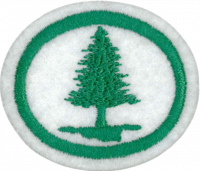AY Honors/Trees/Answer Key
1
Trees are generally taller than shrubs and have a main trunk from which all the secondary branches grow. Shrubs are generally shorter and may have multiple stems rather than a single trunk. Some plants can be considered either shrubs or trees depending on their growing conditions, so the division should not be considered exact.
2
3
3a
- Sweet Gum: the gummy sap of this tree has been used as chewing gum.
- Cork Oak forms a thick, rugged and corky bark. Over time this bark can develop considerable thickness, and this is harvested every 10-12 years as cork.
- Balsam Fir: produces a resin which is known as Canadian Balsam. A balsam is the same thing as a balm, a soothing liquid - anything that soothes, heals, or restores.
- Boxwood: produces a tight-grained wood ideal for carving or for making boxes.
3b
- Mountain Ash grow in the mountainous areas of the northern US and Canada.
- Swamp Ash live in the swamps of the southern US.
3c
- Sugar Maple: The primary source of sugary maple syrup.
- Hornbeam: The common English name of "hornbeam" derives from the hardness of the wood (likened to horn) and the Old English beam, meaning a tree (like the German word "baum" which we know as "tannenbaum").
- Tulip Tree: is so named because its flowers resemble tulip flowers.
3d
- Brazilwood: is not named after Brazil - Brazil is actually named for the tree!
- Cedar of Lebanon, is a coniferous tree native to the mountains of the Mediterranean region, in Lebanon, western Syria and south central Turkey
- Mexican Buckeye is a shrub or small tree native to northeastern Mexico and adjacent western Texas and southern New Mexico.
3e
- Douglas Fir: The common name honors David Douglas, the Scottish botanist who first introduced the tree into cultivation in 1826.
- Fraser Fir: named after John Fraser, a Scottish botanist. Fraser Firs are farmed and sold as Christmas trees.
4
The two great classes of trees are the gymnosperms and angiosperms. The gymnosperms do not produce flowers, but rather, produce naked seeds usually attached to the scale of a cone (such as a pine cone). The angiosperms do produce flowers which in turn become seed-bearing fruits (or nuts). More commonly, the gymnosperms are called evergreens, though this is not an accurate term because some angiosperms are evergreen (such as palms and the live oak). Also, the Ginkgo is a gymnosperm, but it is not evergreen. Gymnosperms and angiosperms are also commonly referred to as softwoods and hardwoods though those terms are not terribly accurate either, as several gymnosperms have hard wood and several angiosperms have soft wood.
5
Properly managed, forests are a renewable resource. In order to ensure a continuous supply of forest products (such as lumber), forests must be properly cut and replanted. Forests also serve as an important habitat for several species, both animal and plant. When plants lose their habitat they simply die. When animals lose their habitat, some will die and others will move into other areas - notably, areas where humans live. This promotes undesirable encounters between potentially dangerous animals and humans, with the animal invariably getting the short end of the stick.
6
6a
Oak, maple, pine, teak.
6b
Pine, fir, spruce
6c
Walnut, oak, cherry, maple, pine, mahogany
6d
Hickory, ash
6e
Locust, cedar, redwood, fir (treated)
6f
Hardwoods and softwoods.
6g
Oak, hickory, ash
6h
Osage orange, yew, and elm for bows. Cedar, spruce, and fir for arrows
6i
Softwoods such as pine and cedar.
6j
Hardwoods, especially hickory and mesquite.
7
7a
Bald Cypress, Sycamore, Willow, Swamp White Oak, Swamp Chestnut Oak, Overcup Oak, Tupelo Gum and Cottonwood.
7b
Larch, Bristlecone Pine (and many other pines), Birch, and Beech.
References
- Trees of North America, A Guide to Field Identification, by Brockman and Merrilees. Golden Press, New York, Copyright 1986, 1979, 1968.


